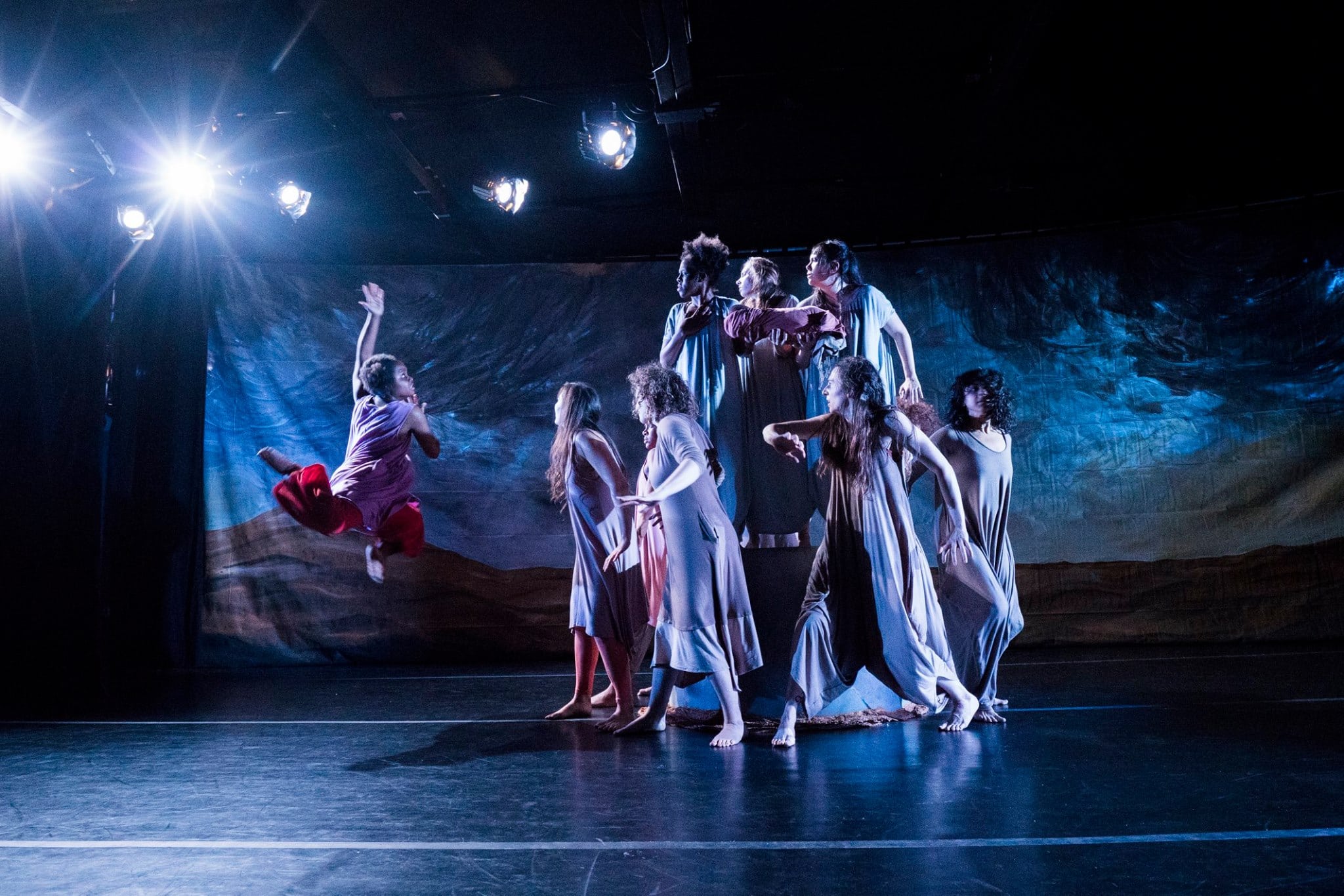When The Rite of Spring, a ballet with a score by Igor Stravinsky, premiered in 1913, theater-goers were so shocked by Stravinsky’s relentless, stabbing music and Vaslav Nijinsky’s avant-garde choreography that they rioted. A critic went so far as to call the show “a laborious and puerile barbarity.” Today, The Rite of Spring is considered a groundbreaking piece of dramatic art, and some scholars say that it sparked the rise of modernism. No doubt that’s why Pointless Theatre chose to adapt Stravinsky’s score and story into a tight, shocking, and physically challenging production that feels very 2018. The sheer energy and emotion that the dancers pour into their movements makes the Pointless take on The Rite of Spring a success.

The original The Rite of Spring tells the story of a Slavic tribe celebrating the return of springtime. But it’s no peaceful celebration: they choose a young girl to sacrifice, and she dances herself to death. The Pointless version is no less violent, and the threat of death runs through the show like an exposed wire. In the end, when death does visit Reckless’s tribe of desert women, it feels even more shocking than if that death hadn’t been presaged at all.
In Patti Kalil and Matt Reckeweg’s adapted story, humans have scorched the earth into an unlivable wasteland. Only a few have survived, and the narrative centers on a ragtag group of women trying to produce enough water to live. The tribe’s sage, an ancient-faced puppet designed by Amy Kellett and masterfully controlled by the tribe’s elders (Anne Flowers, Eirin Stevenson, and Elizabeth Ung), prophesies that they will find water if someone in the tribe offers herself as a sacrifice. Then the sage dies, and the tribe members are left the harrowing task of choosing which one must take on the role of sacrifice. Ultimately, they make a choice as fueled by desperation as it is by cowardice, and only one member of the tribe (a terrifically expressive Deidre Staples) dares fight back.
This is a story with a message: to survive, humans are willing to do terrible things to both each other and to the environment. In fact, half of all the money Pointless Theatre raises during the run of The Rite of Spring will go to Casey Trees, a D.C. nonprofit that works to restore the city’s tree cover. The environmentalist theme couldn’t be more appropriate in 2018, the year that the Doomsday Clock has hit two minutes to midnight.
In addition, The Rite of Spring shows that all people have the capacity for both great violence and for moments of resistance. Men don’t exist in this world, and it is women – whose energy is usually thought of as nurturing, soft, or sensual – who attack, who threaten, who dissent. A woman decrees that the only way to live is through death, and another woman fights back against that idea. That Director Matt Reckeweg would coach his performers to successfully convey all this through body language alone is a triumph.
Aesthetically, the show references the tribe of the Vuvalini, a group of hardscrabble women living in the post-apocalyptic wilderness of the 2015 hit Mad Max: Fury Road. Frank Labovitz’s costumes are simple, but highly effective. The Workers (Janine Baumgardner, Acacia Danielson, Emmanuella Enemor, Sara Herrera, Sadie Leigh, Anna Lynch, and Sharalys Silva-Vázquez) wear shapeless dresses and harem pants in shades of taupe. Their hair is wild, and their faces are stained with dirt. The Elders wear similar costumes, but in blue. Only the Child (Staples) wears color. Reddish pants and a purple tunic mark her as still vibrant, despite the harshness of the world she’s grown up in.
Mary Keegan’s set is bare except for a round, flat piece of stone in the center, which the cast uses to excellent effect as they dance. A backdrop of hazy sand and dim sky, painted by Jean Yang, lets the lights (also designed by Keegan) play across the stage in stormy surges.
Unfortunately, The Rite of Spring is yet another show that tries to use projections to dress up the set, but instead distracts the eye and muddies the action. Patty Rangel’s mixed media projections add little to the lighting and set, and I often found myself wishing that the projections would stop so that I could see the dancers clearly.
That’s a minor complaint compared to the wonder of Kathy Gordon’s energetic, expressive choreography, which (along with Lex Davis’s fight choreography) drives the show. The dancers lunge, spin, and creep across the stage, using their entire bodies to convey meaning. It looks harder to dance this show than to run a marathon, but the performers never falter. Particularly effective: Anne Flowers as the most aggressive of the Elders. Her face, made gaunt by makeup, looks truly demonic as the show hurtles towards its violent climax. Acacia Danielson finds the softness in the choreography’s sharp movements, and Sara Herrera as the Child’s mother (I think?) portrays love, fear, and eventual capitulation with just her body.
The final tableau of The Rite of Spring left me frozen to my seat. Audience members, not sure if what they’d just seen was the end – could something that awful really be the end? – sputtered into a round of applause as the cast took well-deserved bows. As I left Dance Loft, the air felt soft on my skin, and the ground smelled fresh, like spring.
Something wet brushed my cheek. I touched it with my fingers, then looked up.
The show was over, and it had begun to rain.
Running Time: 70 minutes, with no intermission
The Rite of Spring plays through May 27, 2018, at the Dance Loft – 4618 14th St NW, in Washington, DC. For tickets, purchase them online.




